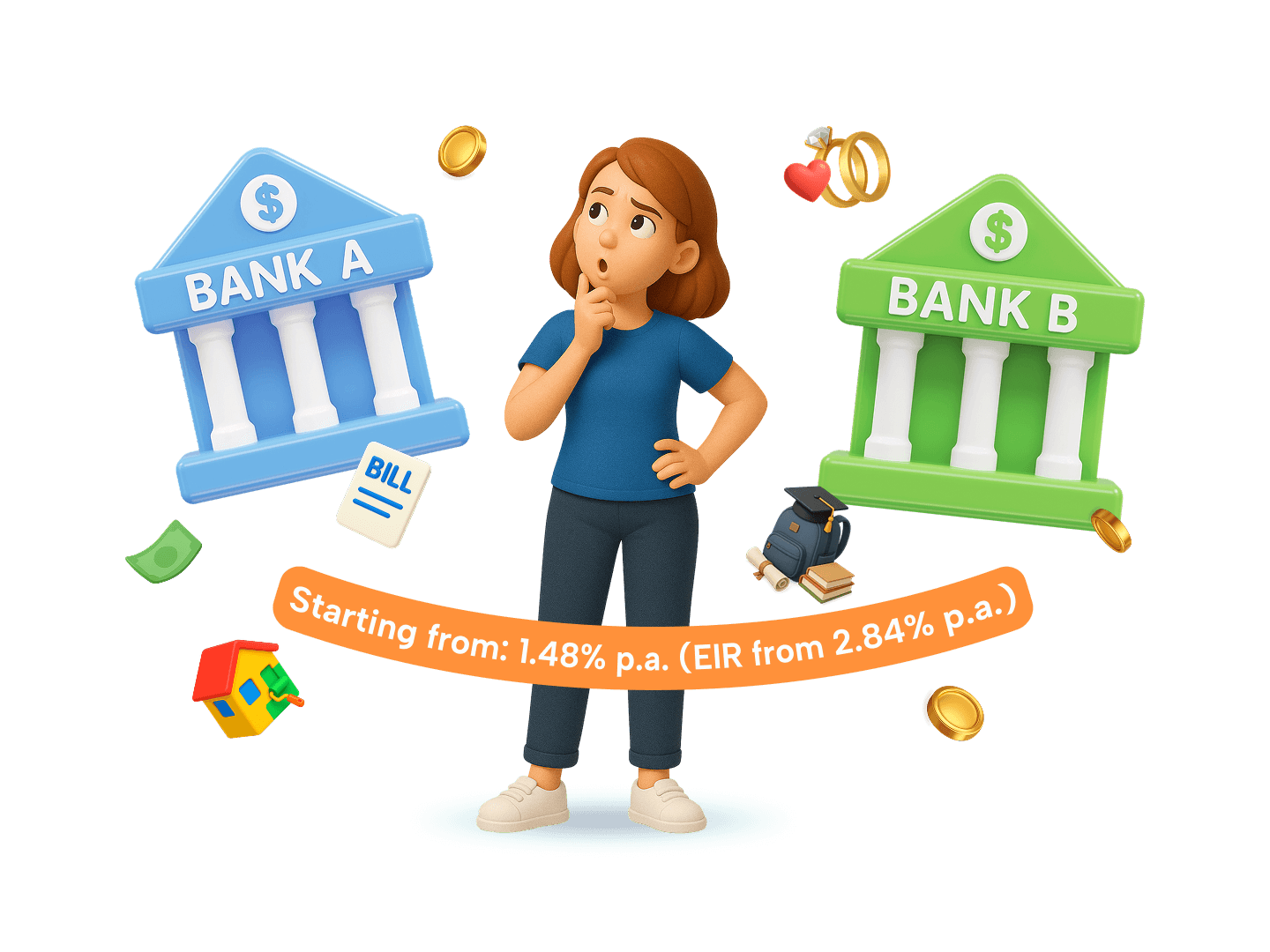Master Your Finances: The Ultimate Student Loans Calculator
Updated: 12 Dec 2025
Understanding Student Loans in Singapore
Singapore student loans play a crucial role in education financing options for many aspiring scholars. These loans offer a pathway to higher education for those who might otherwise struggle to afford it. Let's explore the various aspects of student loans in Singapore to help you make informed decisions about your educational future.
Types of Student Loans Available
In Singapore, students can choose from government-backed and private loans. Government loans, such as those offered by MOE and CPF, often come with more favourable terms. Private banks and financial institutions provide alternative options, catering to different needs and circumstances.
Interest Rates and Repayment Terms
Interest rates for Singapore student loans vary widely. Government loans typically offer lower rates, starting from around 2.5% per annum. Private loans may have higher rates, ranging from 4% to 6%. Repayment terms usually begin after graduation, with some loans offering grace periods.
Eligibility Criteria for Student Loans
Loan eligibility depends on several factors. For government loans, Singaporean citizenship is often a requirement. Private loans may be available to permanent residents and international students. Academic performance, course of study, and the chosen institution also influence eligibility. Some loans require a guarantor, typically a parent or guardian with a stable income.
Understanding these aspects of student loans in Singapore is essential for making sound financial decisions about your education. Always compare different education financing options and carefully consider your loan eligibility before committing to any agreement.
The Importance of a Student Loan Calculator
A student loan calculator serves as a crucial financial planning tool for students navigating the complex world of education financing. This invaluable resource empowers learners to make informed decisions about their academic future and financial well-being.
By utilising a loan calculator, students can perform accurate loan repayment estimations. This allows them to visualise their future financial obligations and plan accordingly. The calculator takes into account factors such as loan amount, interest rate, and repayment term to provide a clear picture of monthly payments and total interest accrued over time.
One of the key benefits of a student loan calculator is its ability to facilitate budget management. Students can experiment with different scenarios to find a loan package that aligns with their financial capabilities. This proactive approach helps prevent overextension and ensures a manageable debt load post-graduation.
-
Compare various loan options side-by-side
-
Assess the impact of different interest rates
-
Evaluate the effects of longer or shorter repayment terms
Armed with these insights, students can confidently choose the most suitable financing option for their unique circumstances. A well-informed decision at this stage can lead to significant savings and reduced financial stress in the long run.
In essence, a student loan calculator is an indispensable tool for anyone considering education financing. It brings clarity to complex financial decisions, enabling students to embark on their academic journey with confidence and financial foresight.
SingSaver Personal Loans Cashback Offer
Enjoy interest rates as low as 1.48% p.a. (EIR from 2.84% p.a.) and up to S$1,900 in cashback when you apply for a personal loan via SingSaver. Valid till 1 January 2026. T&Cs apply.
How to Use a Student Loan Calculator
A student loan calculator is an essential tool for financial simulation and planning your education costs. This loan calculator guide will help you navigate through the process of estimating your repayment scenarios.
Input Parameters
To start using a student loan calculator, you'll need to input several key parameters:
-
Loan amount
-
Interest rate
-
Loan term (in years)
-
Repayment frequency (monthly, quarterly, annually)
Interpreting the Results
Once you've entered the data, the calculator will generate results showing:
-
Total amount repayable
-
Monthly repayment amount
-
Total interest payable
These figures give you a clear picture of your financial obligations over the loan term.
Adjusting Variables for Different Scenarios
Exploring various repayment scenarios is crucial for effective financial planning. Try adjusting the loan term or interest rate to see how it affects your monthly payments and total interest.
By comparing different scenarios, you can make informed decisions about your student loan and plan your finances effectively.
Features of an Advanced Student Loan Calculator
Advanced student loan calculators offer a range of sophisticated features to help borrowers make informed decisions. These comprehensive loan analysis tools go beyond basic calculations, providing in-depth insights into various repayment scenarios.
One key feature is the ability to simulate early repayment options. Users can input extra payments and see how this impacts their loan term and total interest paid. This feature is invaluable for those looking to save money in the long run.
Another crucial component is the refinancing simulator. A student loan refinancing calculator allows borrowers to compare their current loan terms with potential refinancing options. This helps in determining if refinancing could lead to significant savings.
-
Interest savings calculations
-
Multiple loan comparison
-
Customisable repayment plans
-
Tax deduction estimations
These advanced financial tools often include visual representations of data, making complex financial information more accessible. Graphs and charts can illustrate the impact of different repayment strategies over time.
By utilising these advanced features, borrowers can gain a more comprehensive understanding of their loan repayment strategies and make better-informed financial decisions.
SingSaver x HSBC Personal Loan Exclusive Offer
Enjoy attractive interest rates from 1.83% p.a. (EIR from 3.5% p.a.) plus get up to S$1,100 in Cashback when you apply for HSBC Personal Loan via SingSaver. Available to new and existing customers! Valid till 1 January 2026. T&Cs apply.
Student Loan Calculator: Crunching the Numbers
A student loan calculator is an invaluable tool for loan repayment analysis and payment planning. It helps you understand how different factors affect your loan, allowing you to make informed decisions about your education financing.
Loan Amount and Interest Rate Impact
The loan amount and interest rate significantly influence your total repayment. A higher loan amount or interest rate increases your overall cost. For example, a $50,000 loan at 4% interest costs less over time than the same loan at 6% interest.
Repayment Period Considerations
The length of your repayment period affects both your monthly payments and total interest paid. A longer repayment period typically means lower monthly payments but higher total interest over time. Consider this trade-off when planning your finances.
Monthly Payment Calculations
Your monthly payment is determined by your loan amount, interest rate, and repayment period. Interest calculations are crucial in understanding how much you'll pay each month. Use a calculator to see how changing these variables affects your payments.
By utilising a student loan calculator, you can explore various scenarios and create a realistic payment plan that fits your financial situation.
Strategies for Efficient Loan Repayment
Mastering debt management is crucial for students navigating loan repayment. By employing smart loan repayment tactics, you can save money and reduce stress. Let's explore some effective strategies to help you manage your student loans efficiently.
One powerful approach is making extra payments whenever possible. This tactic can significantly reduce your overall interest and shorten your loan term. A student loan calculator can help you visualise the impact of these additional payments on your debt.
Prioritising high-interest loans is another savvy move. By focusing on paying off loans with higher interest rates first, you'll minimise the total interest paid over time. This strategy, known as the debt avalanche method, is a cornerstone of effective debt management.
Budgeting plays a vital role in successful loan repayment. Create a detailed budget that accounts for all your expenses and allocates a specific amount towards loan payments. This helps ensure you're consistently meeting your financial obligations.
Understanding early repayment benefits can also be advantageous. Some lenders offer incentives for paying off loans ahead of schedule. Always check with your lender about potential early repayment benefits to maximise your savings.
Remember, a student loan calculator is an invaluable tool for implementing these strategies. It allows you to experiment with different repayment scenarios, helping you find the most efficient path to becoming debt-free.
⚡ SingSaver x DBS/POSB Personal Loan Flash Deal ⚡
Enjoy interest rates from 1.48% p.a. (EIR from 2.84% p.a*) when you apply for a DBS/POSB Personal Loan. Plus, get S$550 on top of up to 3% cashback when you apply for a loan min. S$10,000 with a min. tenure of 3 years. Use the promo code (SINGSAVER) upon application. Valid till 1 January 2026. T&Cs apply.
Comparing Different Loan Options
When it comes to student loans, making the right choice can significantly impact your financial future. A thorough loan comparison is essential to understand the best option for your needs.
Government vs Private Loans
Government loans often offer more favourable terms compared to private loans. They typically have lower interest rates and more flexible repayment options. Private loans, while potentially more accessible, may come with higher interest rates and stricter repayment terms.
Fixed vs Variable Interest Rates
Interest rate types play a crucial role in loan selection. Fixed rates provide stability, keeping your payments consistent throughout the loan term. Variable rates might start lower but can fluctuate, potentially increasing your payments over time.
Refinancing Opportunities
Student loan refinancing can be a game-changer for managing your debt. It involves taking out a new loan to pay off existing ones, potentially securing a lower interest rate or more favourable terms. Consider your current financial situation and future goals when exploring refinancing options.
Remember, each loan option has its unique benefits and drawbacks. Use a student loan calculator to compare different scenarios and make an informed decision that aligns with your financial objectives.
Student Loan Refinancing Calculator: Is It Worth It?
Refinancing your student loan can be a smart financial move. A student loan refinancing calculator helps you weigh up the loan refinancing benefits against potential drawbacks. By inputting your current loan details and comparing them with new offers, you can see if refinancing makes sense for your situation.
One of the main advantages of refinancing is interest savings. If you qualify for a lower interest rate, you could save a significant amount over the life of your loan. For example:
Another factor to consider is repayment term adjustments. Extending your loan term can lower monthly payments, while shortening it might increase them but reduce overall interest. The calculator helps you find the right balance between affordable payments and total cost.
Before deciding, remember to factor in any fees associated with refinancing. Some lenders charge origination fees that could offset potential savings. Use the calculator to compare different scenarios and determine if the long-term benefits outweigh any short-term costs. Ultimately, a student loan refinancing calculator is a valuable tool for making informed decisions about your financial future. It allows you to explore various options and find the most beneficial refinancing strategy for your unique circumstances.
Student Loan Payoff Calculator: Planning for the Future
A student loan payoff calculator is a powerful tool for debt-free planning. It helps you map out your financial goals and create a solid repayment strategy. By inputting your loan details, you can visualise your path to becoming debt-free.
Using this calculator, you can experiment with different scenarios:
-
Increase monthly payments to shorten the loan term
-
Explore the impact of refinancing on your repayment schedule
-
Calculate potential savings from making extra payments
Setting clear financial goals is crucial for effective loan management. The student loan payoff calculator allows you to track your progress and adjust your strategy as needed. You might aim to pay off your loan in five years or allocate a specific percentage of your income towards repayments.
Regular use of the calculator can keep you motivated. As you see your balance decrease, you'll be inspired to stick to your plan. Remember, consistency is key in achieving your debt-free dreams.
By leveraging this tool, you're taking control of your financial future. Whether you're just starting repayment or looking to accelerate your progress, the student loan payoff calculator is an invaluable resource for your debt-free planning journey.
CIMB Personal Loan Welcome Offer
Enjoy low interest rates from 1.60% p.a. (EIR from 3.07% p.a.) when you apply for a CIMB Personal Loan! Valid till 1 January 2026. T&Cs apply.
Common Mistakes to Avoid When Using Loan Calculators
Student loan calculators can be powerful tools for financial planning, but they're not foolproof. Many users make financial planning errors that can lead to inaccurate results. One common mistake is forgetting to include additional fees in the calculations. These extra costs can significantly impact the total amount you'll need to repay.
Another pitfall is underestimating interest rates. It's crucial to use the most up-to-date rates for calculator accuracy. Remember, even a small difference in interest can add up to thousands of dollars over the life of your loan. Be sure to double-check your figures and use reliable sources for interest rate information.
Setting unrealistic expectations is a third common error. While it's great to aim high, be honest about your future income and expenses. Overestimating your ability to make repayments can lead to financial stress down the road. Use the calculator to explore different scenarios and find a balance between ambitious goals and realistic expectations.
By avoiding these mistakes, you can make the most of student loan calculators. They're valuable tools for mapping out your financial future, but remember - they're only as good as the data you input. Take your time, double-check your figures, and use the results to make informed decisions about your education and finances.
FAQ
A student loan calculator is an online tool that helps you estimate your monthly loan repayments, total interest costs, and overall loan repayment timeline based on factors such as the loan amount, interest rate, and repayment period.
A student loan calculator is crucial for financial planning as it allows you to understand the true cost of your education loan, compare different loan options, and create a realistic repayment plan that fits your budget.
To use a student loan calculator effectively, you typically need to provide details such as the total loan amount, interest rate, loan term (repayment period), and any applicable fees or additional costs.
The calculator will provide you with information like the estimated monthly payment, total interest paid over the loan term, and the overall cost of the loan. These results can help you assess the affordability of different loan options and make informed decisions.
Yes, most student loan calculators allow you to adjust variables such as the loan amount, interest rate, and repayment period to compare different scenarios and find the most suitable option for your financial situation.
Advanced student loan calculators may offer features like loan refinancing options, early repayment simulations, and interest savings calculations. These tools provide a more comprehensive analysis of loan repayment strategies.
Higher loan amounts and higher interest rates will result in larger monthly payments and a higher total cost of the loan over time. Using a calculator can help you understand the impact of these factors on your repayment obligations
Efficient loan repayment strategies include making extra payments, prioritising high-interest loans, and budgeting effectively. A student loan calculator can help you implement these strategies by showing the impact of different repayment plans.
A student loan calculator allows you to compare various loan options, such as government vs. private loans, fixed vs. variable interest rates, and refinancing opportunities. You can input the details of each option and evaluate the costs and repayment terms.
A student loan refinancing calculator helps you determine if refinancing your loans at a lower interest rate would be beneficial. It can show you the potential interest savings and adjusted repayment terms, allowing you to decide if refinancing is worthwhile.



